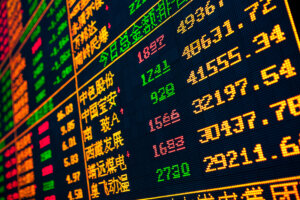Chinese economy likely to remain strong long-term?

• The Chinese economy has until recently been growing exponentially.
• Bullish behavior from the US has had a negative effect on the Chinese economy.
• It will probably take a lot more to upset the country’s growth long-term.
It’s no secret that China’s recent economic performance is a far cry from its persistent high growth patterns over the last three decades. In those thirty or so years, China’s economy transformed into an upper-middle-income status from one that was low-income. Just a quick glance at market exchange rates shows a GDP of $18.3 trillion in 2022. This was 73% of the United States’ GDP, with China’s per capita income now approximately $13,000. This equates to around 17% of the United States’ per capita income. When we consider China’s was less than two percent of the US’ 34 years ago, the country’s economic growth has been remarkable.
What goes up tends to come back down, though, and economists have long forecasted an economic collapse for China due to various fragilities. For instance, the country’s growth has been powered by investments in physical capital, particularly real estate. This, in turn, has been financed by a banking system that lacks certain efficiencies. Now, it seems those forecasters were correct, as China struggles with rising debt levels, crashing stocks, weaker consumer confidence, a diminishing labor force, and an unraveling property market.
Despite the country’s economic struggles, China still sits at the top of the pile in terms of being the world’s leading manufacturing force, according to Eurizon strategists. Compared to its rivals, China’s manufacturing capacity is far greater. Coupled with the fact that export prices have risen by 30% and 31% in Mexico and Vietnam respectively over the last three years, two of China’s most prominent competitors, it seems China will continue to reign supreme as the world’s most dominant manufacturer.
China’s labor force far outweighs the combined economies of the US, Japan, Canada, the EU, India, Korea, Vietnam, and Mexico, estimated to be around 212 million. This backs up a point made by Eurizon strategists, Stephen Jen and Joana Freire. “We believe the fact that export prices have risen more rapidly than general inflation – a remarkable fact in a period of a strengthening dollar – indicates stresses and pressures on the manufacturing capacity in these countries, including shortages of appropriate workers, infrastructure, and transport.”
Yes, other countries may start to gradually shift away from China in global manufacturing, but it is unlikely smaller nations will have the power and abilities to adapt to rapid changes to be on par with China’s dominance. Jen and Freire agree that there is little evidence of deglobalization, stating, “no other country has the manufacturing capacity to supplant China.” Even countries that are exporting more to the US in place of China, such as Mexico, are importing more than ever from – you guessed it – China.
Economic growth prospects
Predicting China’s growth is a challenging task, with only a crystal ball offering any glimpse of accuracy right now. Nevertheless, productivity may be the engine to power future economic success. Although the country has faced struggles, and continues to do so, its total factor productivity (growth not attributed to increased inputs) has averaged a respectable 3% growth over the last few decades.
However, productivity growth has dropped to about one percent a year over the last decade. If this trend continues, China may face further economic challenges. This is why China must improve its productivity growth, as relying solely on increased inputs, like capital and labor, may not be sufficient for long-term economic success.
The Chinese government has recognized the need for improvements in productivity, moving away from low-skill manufacturing. The government’s answer is a “dual circulation” growth policy, one that enhances worldwide finance and trade, relying more on domestic demand, homegrown innovations, and being technologically self-sufficient.
This policy faces some difficulties though, as China can only upgrade its industries by relying on foreign technology. The issues lie in geopolitical and economic conflicts with the West and the US. Therefore, access to such technologies and export markets may become strained and limited. Add to this the government’s clampdown on private companies in areas like education, health, and technology, and it’s clear that entrepreneurship in the country is also facing tight constraints and negative impacts.
Sectors, including electric vehicles, green energy, technology platforms, and electronics continue to be bright beacons of hope in a tumultuous Chinese economy, with slight recoveries after substantial drops in July and August 2023.

The Chinese economy – surging or stalling?
We mustn’t forget that China remains the world’s second-largest economy, still a center for manufacturing and supply chains, global exports, and home to some of the biggest brands, like TikTok, Tencent, and Alibaba. So, maybe all this worry is a bit far-fetched?
Not if we look at Japan.
The Japanese example
30 years ago, Japan was leading the way with technological innovations and leadership. But, even with this, the country faced significant economic turmoil, mass debt, and institutional weaknesses; all of which undermined the country’s prosperity and growth. Being a technological powerhouse did not prevent Japan from facing difficult decades; there is little reason why the same should not apply to China.
To help stabilize the country’s economy, 2024 is expected to bring tax cuts and fee reductions for businesses, with additional support for the struggling housing market.
Right now, there do not seem to be any stringent measures planned to improve consumer demand or boost household incomes. Instead, the government is working to strengthen public opinion and economic propaganda. The goal? To promote a more positive view of the Chinese economy, even if it is beleaguered.
The key interest area of focus is between China and the United States. In November, Chinese President Xi Jinping met with Joe Biden, with both hoping to stabilize their external diplomatic relationship. Xi also met with EU Commission officials in an attempt to maintain a close relationship for access to technology and trade. This doesn’t rule out an upcoming trade war between China and the EU, though; instead, it’s Xi trying to smooth out his country’s economy.
China’s industrial policy is centered around access to foreign technology, the widespread use of large-scale industrial funds, and state subsidies. Previously, this has led to an oversupply of production capacity, particularly in sectors like renewables and steel. This is now evident in China’s battery and electric vehicle production.
The auto industry in China has been operating at less than 60 percent of its total production capacity. In addition, approximately 12% of its current production of 27 million units have been exported, with the production of electric vehicles notably increasing. Excess capacity in sensitive areas, like renewables and steel, can lead to economic inefficiencies and trade tensions are ever present. But having access to foreign technology could be a key solution to accelerating China’s innovations and technological advancements, potentially positioning China as a continuing leader in various sectors and technologies.
When compared to the US, the EU has significantly lower tariff rates, offering more opportunities for Chinese exports of vehicles. However, an anti-subsidy investigation has been initiated by the EU, which may lead to tariffs and restrictions on Chinese electric car imports. With the U.S. also taking measures to boost the manufacturing capabilities in renewables, electric vehicles, and semiconductors, China may have to face some tough stances, particularly in trade policies, as 2024 progresses; even more so if Trump gets reelected.
For now, China remains the world’s largest exporter, boasting an estimated global market share of 15%. This marks an all-time high when the Chinese economy is facing one of its lowest points in recent history.










